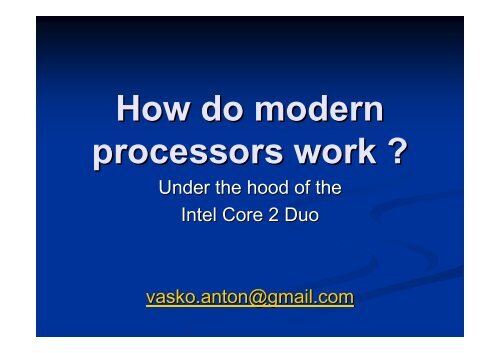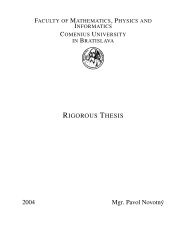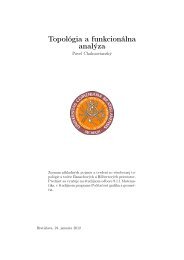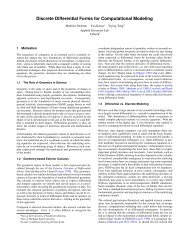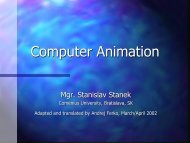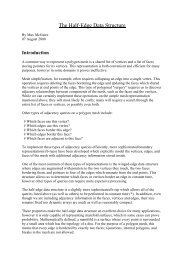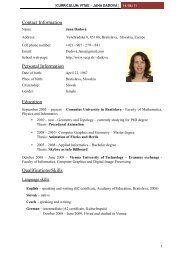How do modern processors work ?
How do modern processors work ?
How do modern processors work ?
You also want an ePaper? Increase the reach of your titles
YUMPU automatically turns print PDFs into web optimized ePapers that Google loves.
<strong>How</strong> <strong>do</strong> <strong>modern</strong><br />
<strong>processors</strong> <strong>work</strong> ?<br />
Under the hood of the<br />
Intel Core 2 Duo<br />
vasko.anton@gmail.com
Description<br />
dual core<br />
64-bit (EMT64 = AMD64)<br />
4-issue<br />
out-of<br />
of-orderorder<br />
32 KB L1 instruction cache<br />
2 x 32 KB dual ported L1 data cache<br />
shared 4MB L2 cache<br />
clock about 3GHz<br />
2
Microarchitecture<br />
3
Sub-blocks<br />
blocks<br />
Front end<br />
Out-of<br />
of-order order Engine<br />
Memory Subsystem<br />
4
The Front End<br />
5
Macro-op op Fusion<br />
load eax, [mem1]<br />
cmp eax, [mem2]<br />
load eax, [mem1]<br />
cmp eax, [mem2]<br />
jne<br />
label<br />
jne<br />
label<br />
store [mem3], ebx<br />
inc ecx<br />
store [mem3], ebx<br />
inc ecx<br />
dec0<br />
dec1<br />
dec2<br />
dec3<br />
load eax, [mem1]<br />
dec0<br />
dec1<br />
dec2<br />
dec3<br />
load eax, [mem1]<br />
cmp eax, [mem2]<br />
cmpjne eax, [mem2], label<br />
jne<br />
label<br />
store [mem3], ebx<br />
store [mem3], ebx<br />
inc ecx<br />
inc<br />
ecx<br />
6
µ-ops Fusion<br />
if some instructions requires two<br />
operations => 2 µops<br />
sometimes they can be fused into 1 µop<br />
1 record through the pipeline, split before<br />
execution units/memory<br />
Macro-ops ops fusion for different class of<br />
instruction<br />
7
Out-of<br />
of-order order Engine<br />
False dependency:<br />
mm0 = mm1 + mm2, mm2 = mm3 - mm1<br />
8
Execution Units<br />
SSE instructions are executed in one cycle only!<br />
9
Memory System<br />
10
Features of Memory System<br />
Prefetching (software, hardware)<br />
Directly data transfer between cores’ L1<br />
data caches<br />
Shared L2 cache<br />
Memory Reorder Buffer (MOB)<br />
11
Memory Aliasing Problem<br />
only out-of<br />
of-order order CPU<br />
12
Old solution<br />
1. All loads are delayed if a store is in-flight<br />
with an unknown address<br />
2. Loads cannot proceed ahead of an<br />
aliased store data µop<br />
3. A store cannot be moved in front of<br />
another store<br />
<br />
safe but pessimistic<br />
13
New solution<br />
97+% of loads and stores <strong>do</strong> not alias ([1])<br />
dynamic alias predictor<br />
loads can be speculative moved<br />
if bad prediction -> > exception and flush of<br />
the pipeline (stall)<br />
14
Conclusion<br />
Many features are already available in<br />
AMD <strong>processors</strong><br />
SSE is becoming important (1 cycle)<br />
32-bit CPUs are history – AMD64,<br />
EMT64<br />
Not speed, but parallelism:<br />
1. Logical – SSE<br />
2. Physical - dual core, quad core ...<br />
15
Bibliography<br />
1. http://www.realworldtech.com/includes/templat<br />
es/articles.cfm?ArticleID=RWT030906143144<br />
2. http://www.chip-<br />
architect.com/news/2003_09_21_Detailed_Arc<br />
hitecture_of_AMDs_64bit_Core.html<br />
3. http://www.svethardware.cz/art_<strong>do</strong>c-<br />
3B56A5C905E08771C125715E00793B42.html<br />
16
Thank you for your<br />
attention !<br />
vasko.anton@gmail.com


